How to Spot Keyword Gaps and Outrank Competitors
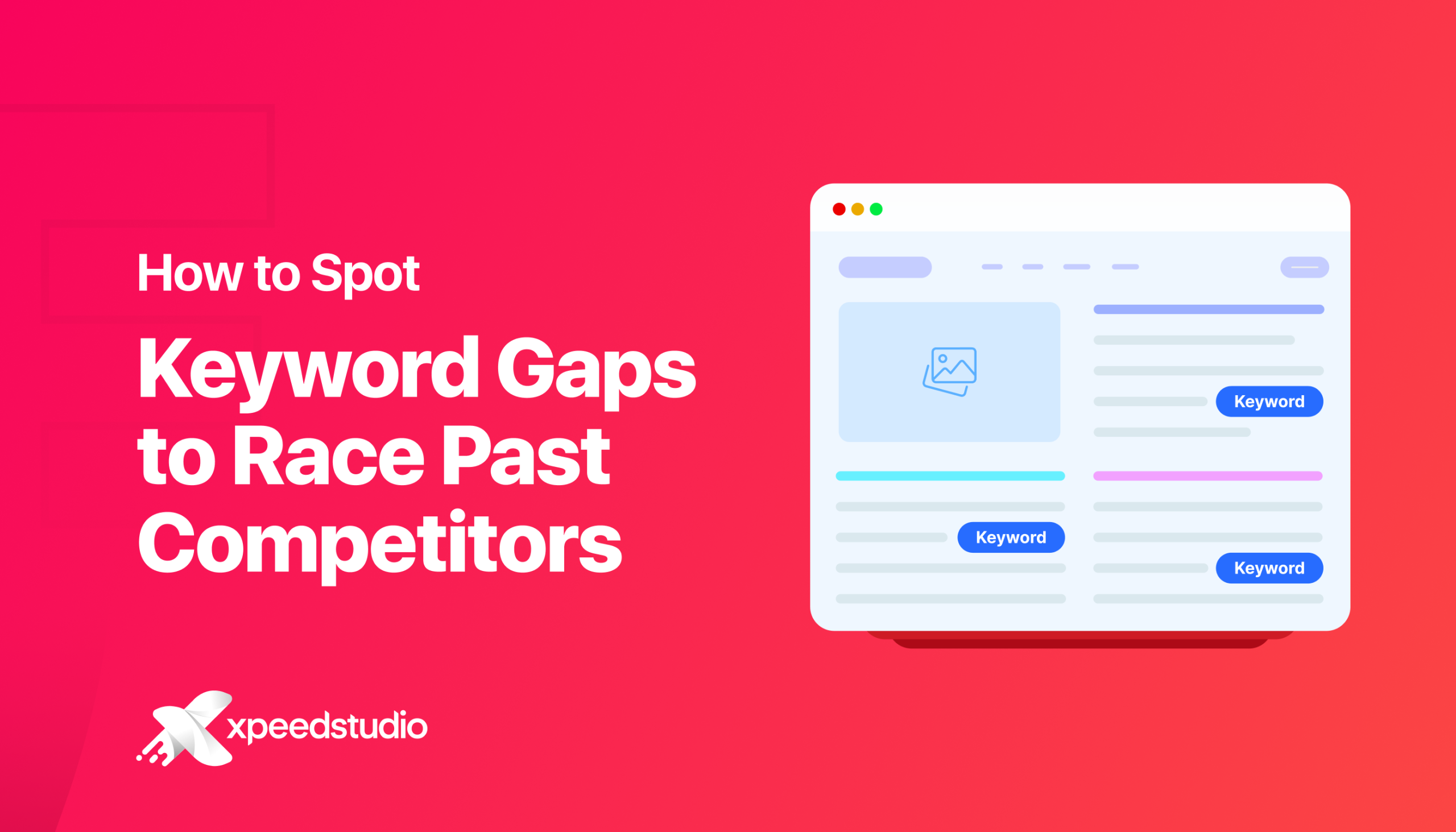
Keyword Gap Analysis helps marketers and SEO specialists find ways to outrank competitors. This powerful strategy reveals missing keyword opportunities where competitor sites are drawing traffic, but yours is not.
By spotting these gaps and filling them with high-quality content, you can boost your SEO keyword coverage and go past competitors. I will walk you through understanding keyword gaps, how to find them, and how to use the insights to leapfrog the competition.
Key Takeaways
Finding keyword gaps to outrank competitors requires:
1. Identifying the competitors
2. Using SEO tools to find out the keyword opportunities
3. Analyzing and prioritizing keyword opportunities
4. Filling the keyword gaps with quality content
Following these steps using the right SEO tools like GetGenie will help the users optimize their website content and pages.
What is Keyword Gap Analysis?
Keyword gap analysis is a process that checks what keywords your website or webpage is not ranking for that your competitors are. It is similar but not exactly the same as content gap analysis which finds weak spots in your content plan, comparing them to your competitors.
For example, let’s say you’re a WordPress plugin company in New Jersey.
You do a keyword gap analysis and find many keywords that your competitors are ranking for but you aren’t. Such as:
“wordpress company in new jersey”
“wordpress services new jersey”
“best wordpress brand new jersey”
But you also do a content gap analysis based on the pain points your customers face at different stages of the customer journey. And find topics you could cover on your website to resolve them. Examples would be:
“How much does a wordpress service charge to fix a site?
“Does wordpress plugin cover AI tools?”
“Do you pay extra for wordpress add-ons?”
How to Identify Keyword Gaps (Step-by-Step)
Finding keyword gaps involves a combination of competitor research and keyword analysis. Below is a step-by-step approach.
Step 1: Identify Your Key Competitors
Start by listing both your direct competitors (businesses offering similar products/services) and SEO competitors. They are the sites that rank for the keywords you want to target, even if they’re not in your industry.
You can use tools Semrush and its feature Organic Research to find out your competitors.
Enter your domain into the tool. And click “Search.” On the report that appears, click “Competitors.”

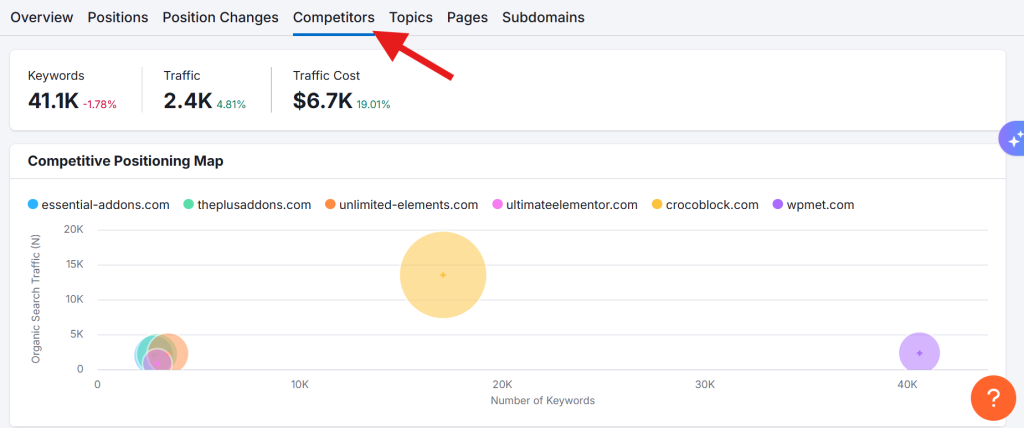
You’ll now see a list of your top organic competitors, how many keywords you have in common with each, and more.
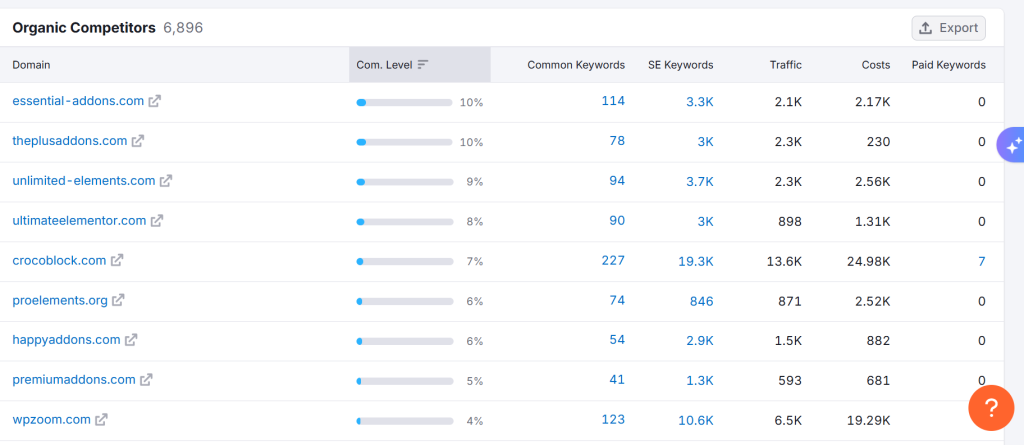
For example, a local WordPress might consider not just other WordPress plugins but also other CMS sites or review blogs ranking for “WordPress plugins”. Use search engines (in incognito mode) to search for some core keywords in your niche and see who consistently appears on the first page.
Step 2: Use SEO Tools to Find Missing Keyword Opportunities
Once you know which competitors to analyze, make the best use of keyword gap analysis tools to compare your site against theirs.
Tools like Semrush’s Keyword Gap or Ahrefs’ Content Gap allow you to input your domain and multiple competitor domains. They automatically find keywords your competitors rank for that you do not.
Semrush, for instance, provides a convenient Venn diagram of keyword overlap and suggests competitor sites if you’re unsure whom to compare. It groups results into segments.
The segments are “missing” keywords, “weak” (you rank, but behind others), “shared” (keywords you and competitors both rank for), “untapped” (at least one competitor ranks, you don’t), and “unique” (keywords only you rank for). These filters help you zero in on true gaps.
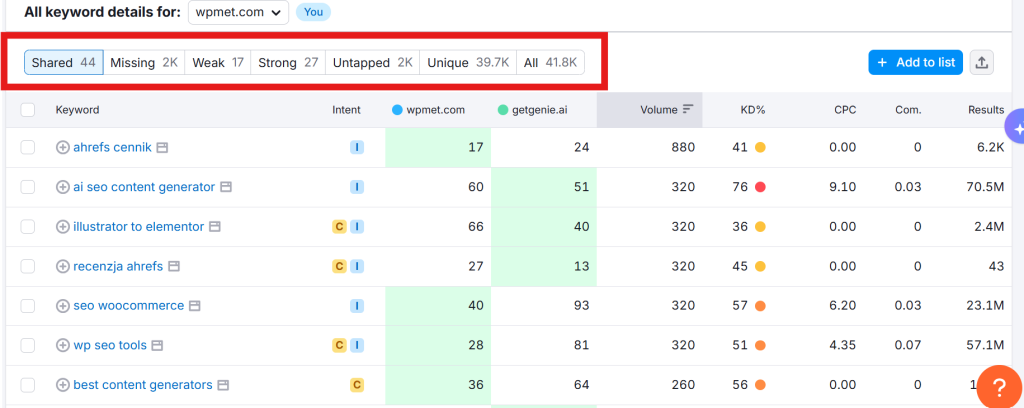
Many SEO professionals also check the “People Also Ask” questions and autocomplete suggestions on Google as a quick way to spot missing subtopics or user questions (content gaps) that their content could cover.
Step 3: Analyze and Prioritize Keyword Opportunities
After generating a list of potential gap keywords, the next step is to evaluate which ones are worth pursuing.
Filter out any keywords that aren’t highly relevant to your business or content goals. The goal isn’t just to chase competitor keywords for the sake of it, but to focus on those that match your target audience’s intent and needs.
For each keyword, ask: “If a user searches this, can we provide a great answer or solution?” If a keyword is outside your scope, it is not a priority even if a competitor ranks for it.
Then, check how closely competitors are ranking for a keyword. Are they dominating the top spot with a very authoritative page, or are they middling on page 2?
If your competitor ranks #1 and has a very comprehensive page, you’ll need a significant effort to outrank them. However, if a competitor ranks in the middle, that is a chance to grab on.
When you are analyzing and prioritizing the gaps, look at the search volume of each keyword and the keyword difficulty or competition level. Many SEO tools provide a difficulty score or label (e.g., “Easy”, “Hard”).
It’s often wise to target some low-hanging fruit; keywords that might not be extremely high volume, but are easier to rank for.
Above all, consider the stage of the buyer journey or content funnel each keyword represents. Some gap keywords will be informational (early-stage research queries), while others might be transactional (ready-to-buy queries). A mix is healthy for a content strategy, but give extra weight to keywords that could directly drive conversions or leads.
Also, note any seasonal or trending keywords among the gaps. If competitors rank for a trend that you haven’t covered, you might want to jump on it fast to ride the wave.
Always ask the following question: Is this keyword likely to bring valuable traffic, and can we realistically rank for it if we produce the right content?
Step 4: Fill the Gaps with Quality Content
Now you need to fill those keyword gaps. This means creating new content or optimizing existing pages to target the chosen gap keywords.
To Create New Content, plan a content piece that will address that topic thoroughly for each high-value missed keyword (or cluster of related keywords). This could be a blog post, a product/service page, a guide, or any other type of content that fits the query.
You can use a tool like GetGenie to create or optimize content. Its Blog Wizard feature offers One-click blog generator and customized content that will help create optimized content. Fast and smooth.
Some keywords from your gap analysis might be closely related to the content you already have. In these cases, it may be better to update and expand an existing page rather than create a new one. You can use the Content Rewriter feature of GetGenie for that, as shown in the video below.
Improve on-page SEO elements by incorporating the new keyword (and related terms) into your headings, body text, meta description, and image alt text, where appropriate. Add a section addressing the topic if it’s not covered yet, or enhance the depth of discussion on that subtopic.
Also, beyond just keywords, look for broader content gaps on the topic. For instance, if competitors’ content includes Q&A or “People also ask” questions that yours doesn’t, consider adding an FAQ section. If their articles have data, infographics, or case studies, and yours is just text, enrich your content with those elements. The idea is to make your page more comprehensive and useful than anyone else’s for that topic.
Tools for Keyword Gap Analysis and Content Optimization
While the concept of finding and filling keyword gaps can be done manually, several tools make the process faster and more data-driven.
| Tool | Keyword Gap Analysis | Content Optimization | Starting price (USD) | Best for |
|---|---|---|---|---|
| Semrush | Dedicated Keyword Gap compares up to 5 domains; shows shared/missing keywords across organic/paid/PLA. | SEO Writing Assistant + On Page SEO Checker | From $139.95/mo; free trial. | All-in-one suite when you want a gap + writing guidance in one place. |
| Ahrefs | Content Gap highlights keywords competitors rank for that you don’t; deep domain/URL-level comparisons. | Optimize via Site Audit (on-page/technical issues) + Content Explorer to find topics and low-competition opportunities. | From $29/mo (Starter). Free Ahrefs Webmaster Tools for your own site. | Competitor & technical depth over an in-editor content grader. (Ahrefs) |
| GetGenie | Head-to-Head (H2H) SERP comparison to spot keyword/content gaps vs top results & competitors. | SEO Insights, Keyword Research, and Blog Wizard for optimized content creation | From $5.50/mo (annual/monthly tiers). | WordPress-first teams wanting affordable AI writing + quick SERP gap checks. |
| Surfer SEO | AI search visibility tracking. | Content Editor with NLP terms + Surfer AI for first drafts | Essential $79/mo (annual) or $99/mo monthly; Scale & Enterprise tiers. | Content teams scaling briefs and on-page optimization (including AI/LLM visibility). |
| Frase | SERP/topic research FAQ to close topical gaps; SEO + GEO (AI/Answer-engine) optimization. | Editor with optimization & AI writing; “Rank-Ready” docs option. | Starter $45/mo (or $38.25/mo billed annually). | Budget-friendly AI content + optimization for SEO and answer-engine results. |
| Clearscope | Topic Exploration + SERP competitor scraping to find coverage gaps; Content Inventory monitors losing position. | Best-in-class content grader/terms/readability | Essentials $129/mo. | Editorial teams wanting premium guidance |
| Google Search Console | Performance report shows your queries/pages | No editor; first-party search data to guide what to optimize next; Insights + URL Inspection. | Free. | Must-use to validate opportunities from any other tool. |
Using GetGenie’s H2H Analyzer to Outrank Competitors
GetGenie offers a feature called Head-to-Head (H2H) Comparison that can be a game-changer when filling keyword gaps. This tool essentially performs a competitor content analysis on your behalf:
First, fetch and compare Top Content
When you enter a target keyword in GetGenie’s interface (for example, via the Blog Wizard in SEO mode) and enable the H2H comparison, the tool will fetch data on the top-ranking pages for that keyword.
It then presents a heatmap comparing how you and your competitors utilize important keywords and topics. You’ll see your draft (or existing content) side by side with, say, the top 5 or top 10 competitor pages, across a list of relevant terms.
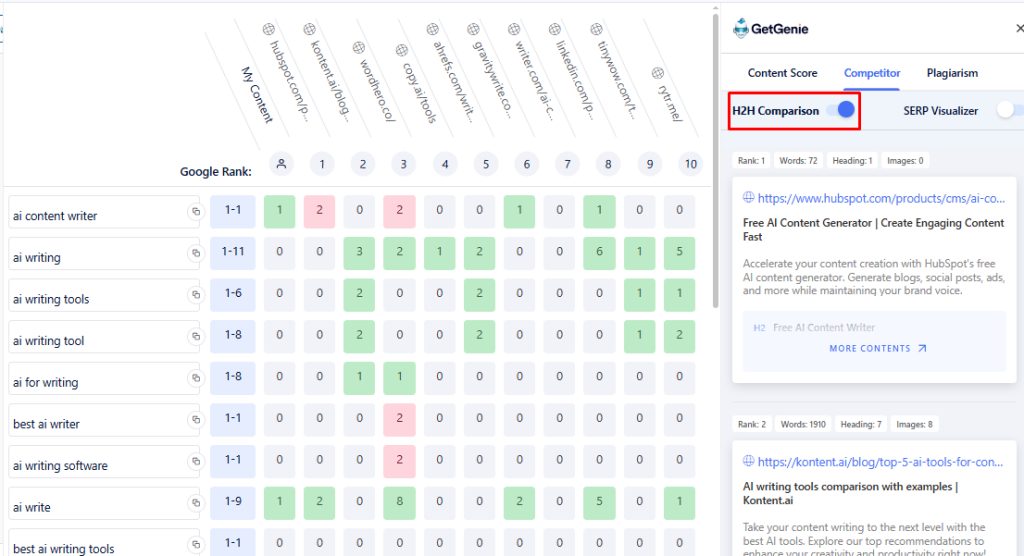
Then, the H2H heatmap uses color-coding to instantly highlight gaps
For example, it shows the expected frequency for each keyword based on competitors, and how many times each competitor and your content uses it.
If a keyword in your content is underused (compared to the optimal range), it might be highlighted in yellow; overused terms are marked red. Green indicates you’re within the ideal range.

As shown above, for the keyword “ai content writer”, the user’s content has used it ideally, once (marked in green). But Hubspot and WordHero’s content have overused it (shown in red). 0 with no color means not used at all.
Following that, Compare Headings and Sections
Besides counting keywords, GetGenie’s competitor analysis tab also pulls in competitors’ content structure; their headings (H1, H2, H3, etc.) and key points. This lets you see what subtopics each top page covers at a high level.
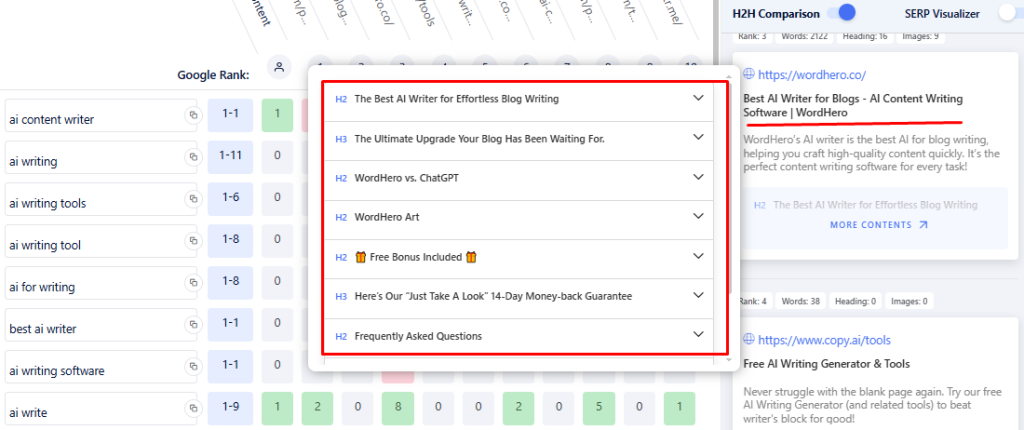
You’ll find a competitor’s article has a section you didn’t think of. For example, if you’re writing about “AI Writing Tool” and most competitors have an H2 on “Automation Tips” or a subsection on “Common Mistakes to Avoid” that you omitted, those could be content gaps to fill.
Finally, Get NLP Keyword Suggestions
The tool’s NLP keyword analysis suggests related terms and entities that are semantically associated with your topic. It provides a list of these keywords and how often they should appear in your content.

Using these suggestions can help ensure you cover the topic comprehensively. For instance, for an article on “AI writing tools,” NLP suggestions might include terms like “content generation,” “content writing,” “writing tools,” etc., which the top content frequently mentions, including these where relevant, can improve your content’s relevance score.

Implementing Your Findings to Fill SEO Keyword Gaps
With your keyword gap analysis done and tools at hand, it’s time to put the insights into action. Here are some best practices for implementing the changes for the above example with focused on “AI Writing Tool” keyword:
- Create a Content Roadmap: Take the prioritized list of gap keywords and plan out a content calendar. Determine which new pieces you’ll create and which existing ones to update.
- Develop High-Quality Content: When crafting content for gap keywords, aim for quality over quantity. Ensure each piece fully answers the search intent. For the keyword ”AI Content Writer”, a shallow 500-word article won’t cut it if competitors have 2,000-word guides. Also, if the majority of competitors focused on product review, your content should most likely be in that niche.
- Use Data and Examples: To stand out, enrich your content with data, statistics, or personal insights that competitors might not have. For instance, include recent stats or case studies about the topic if available.
- On-Page SEO and Internal Links: Optimize on-page elements for each new or revamped page. Write compelling, keyword-inclusive meta titles and descriptions to improve click-through when you do rank.
- Leverage Your Tools During Writing: As you write or edit, keep your SEO tools active. For instance, if you’re using GetGenie’s editor or a content optimization tool, periodically check the suggestions: have you included all the key subtopics? Is your reading level appropriate for your audience? T
- Publish and Promote: Once content is live, remember that promotion can also drive quicker results. Share the new content on your social channels, email newsletters, or communities relevant to your industry.
- Monitor Results: SEO is an ongoing game. Use rank tracking (many tools, including some suites and GetGenie’s SEO insights, offer tracking) to see how your changes are impacting your rankings over the next few weeks and months. If you see upward movement, great. Keep optimizing and perhaps tackle the next batch of gap keywords. If not, you might need to refine further: maybe the content needs additional backlinks, or the keyword difficulty was higher than anticipated.

FAQs
How do you prioritize Keywords?
The best way to analyze and prioritize keywords is by looking at the search volume and keyword competition levels of the keywords. Tools like Semrush, Moz, and GetGenie help you do that.
What is the key difference between Keyword Gap Analysis and Content Gap Analysis?
Keyword Gap Analysis compares keywords your competitors rank for but you don’t. Content Gap Analysis looks at topics or pieces of content your competitors cover but you don’t.
What are NLP keywords?
These keywords understood using Natural Language Processing (NLP) techniques. Unlike simple exact-match keywords, NLP keywords focus on meaning and context, not just exact wording.
Summing Up
Spotting keyword gaps and filling them allows you to outrank competitors by offering content that’s more relevant and complete than anyone else’s. With a mix of savvy analysis, strategic content creation, and tools like GetGenie’s H2H analyzer to guide your optimizations, you can turn those gaps into growth opportunities.
Start analyzing those gaps today. Your next breakthrough ranking might be hiding in a keyword your competitors currently have to themselves. By seizing those opportunities, you’ll drive more organic traffic to your site and leave your competitors wondering how you leapfrogged them in the SERPs.
